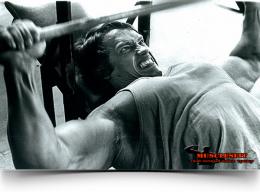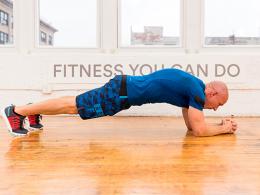Exercises to learn how to pull up on the horizontal bar
Learning how to pull up is not so easy, because the exercise requires strength not only in certain muscles, but in the totality of the muscular and ligamentous apparatus, which must first be prepared. There are exercises to improve pull-ups on the horizontal bar, with which you can develop the necessary muscles, as well as improve the training process.
What muscles work when pulling up
You can pull yourself up in various ways, both with a wide regular grip and a medium reverse grip. Each variation will include different fibers, but the major muscle groups remain the same. Big load when pulling up, the latissimus dorsi muscle, rhomboid, large round muscle, trapezius are exposed. It also helps to pull the body to the crossbar. biceps brachii, brachialis and brachioradialis.
To learn how to pull yourself up on the horizontal bar, do lead-up exercises that involve the same muscles.
Exercises for training pull-ups on the crossbar
Pull-ups on the low bar with a wide grip
This exercise is an easy alternative to pull-ups. By strengthening the muscles on the low bar, resting your feet on the floor, you can gradually develop the necessary muscles and get closer to the heavy version.
Exercise technique:
- Stand facing the bar, set at approximately chest level. The lower the bar, the harder the load.
- Grasp with a wide grip, walk your feet forward, bringing your torso and legs into a straight line at an angle of 45 degrees. Hang freely on straight arms.
- While exhaling, bring the shoulder blades together, with the efforts of the biceps, pull the chest to the crossbar. Keep your elbows at a right angle, at the level of the shoulder joints.
- Relax your arms as you inhale and return to the starting position.
- Keep a straight line of the whole body, do not bend the lower back, do not lower the pelvis. Keep all muscles in good shape.
Pull-ups on the low bar with a reverse grip
This exercise replaces pull-ups with a medium reverse grip. Includes the latissimus dorsi, biceps and forearms. The load is reduced by placing the feet on the floor.
- Grab the bar with an underhand grip across the width of your shoulder joints.
- Step feet forward, forming a 45-degree angle.
- With an exhalation, pull the middle of the chest to the crossbar, bring the shoulder blades to each other.
- Relax gently as you inhale.
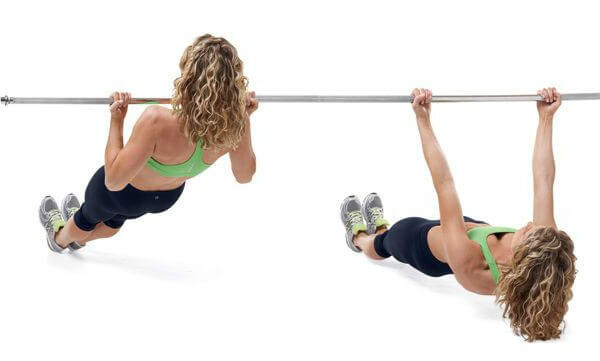
The pull of the upper block behind the head
The exercise increases the number of pull-ups on the bar and develops the strength of the latissimus dorsi, teres major, rhomboid, biceps brachii and forearms, as with pull-ups. .
- Grasp the handle of the simulator with a wide grip, sit down on the seat, rest your hips on special rollers.
- Lean forward a little.
- On the way out, stretch the handle behind your head, without touching the cervical vertebrae. Lower the bar no lower than the back of the head. It is necessary to feel the tension of the back muscles in the lower phase, linger for 1 second.
- While inhaling, slowly raise the handle, do not make sudden movements so as not to injure the shoulder joint.
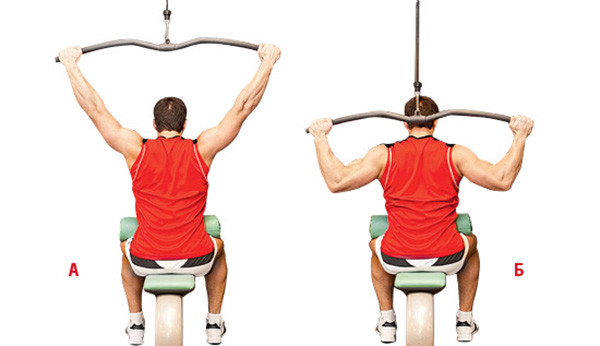
Bent over one dumbbell row.
This exercise with dumbbells will allow you to learn how to pull yourself up on the horizontal bar much faster, using the necessary muscles and ligaments with free weights. In addition to the muscles of the back, rhomboid muscle, biceps and forearms, the rear deltas work.
- Take a dumbbell in your right hand.
- Place the palm of your left hand and the knee of the same leg on the bench, find a stable position.
- Right foot on the floor. The hand with dumbbells is freely lowered below the bench.
- As you exhale, lift the dumbbell to your belt, due to the main efforts of the latissimus dorsi muscle on the right.
- As you inhale, slowly lower, stretching the muscles of the back and arms.
- Repeat first on one hand, then also change position, focusing on the right side.

T-bar pull
The exercise works out all the muscles that work during pull-ups, in addition training the small round muscle, the infraspinatus, also additionally loads the lower back and abdominal muscles. And also this exercise allows you to include stabilizing muscles in the work, strengthen the ligamentous apparatus.
- Place your feet shoulder-width apart, grab the bar with a special handle.
- Tilt your torso forward, keeping your back straight at a 45-degree angle.
- As you exhale, pull to the stomach, stretching the elbows along the body.
- Squeeze your shoulder blades, tensing your back muscles.
- As you inhale, lower the bar and stretch your muscles without rounding your back.
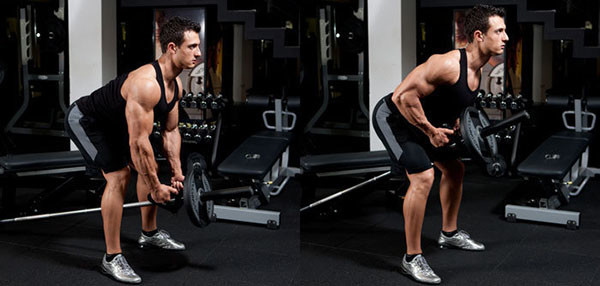
Conclusion
To learn how to pull yourself up on the horizontal bar, it is not enough to perform exercises for the same muscle groups, it is important to gradually master the exercise itself, performing at least 1-2 times. Ask or a friend to back up on pull-ups by pushing the body from below, this will help the body feel the working muscles, as well as learn how to snatch. When training your back and arms for pull-ups, do not forget about other muscles, as even development will allow you to learn more complex techniques faster.


